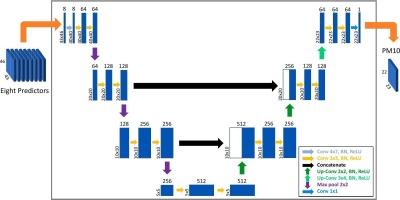利用U-net加强摩洛哥5天颗粒物(PM10)预报:一种深度学习方法
IF 4.4
2区 地球科学
Q1 METEOROLOGY & ATMOSPHERIC SCIENCES
引用次数: 0
摘要
准确预测颗粒物对预防健康风险和保护公众健康至关重要。该研究使用基于u - net的深度学习模型提高了摩洛哥未来五天颗粒物d≤10μm (PM10)预测的准确性,这是中东和北非(MENA)地区首次开展此类研究。利用U-Net模型对哥白尼大气监测服务(CAMS)的PM10预报进行后处理和改进,并以CAMS的再分析数据为参考,指导模型的学习。U-Net架构经过修改,以不同于输入的分辨率预测输出,消除了插值的需要,并保留了关键的空间细节。结果表明,在CAMS预测升级到2023年中期之前的一段时间里,通过提高平均绝对误差(MAE)、均方根误差(RMSE)、决定系数(R2)、一致性指数(IOA)和偏差等指标,特别是在容易发生沙尘暴的地区,CAMS预测和模拟集成模型(AnEn)在两个基线上有了显著改善。在2023年下半年,U-Net继续改善预测;然而,升级周期的影响在其错误中变得明显。这就突出了利用最新数据对U-Net进行再培训以保持其在业务预测系统中的可靠性的重要性。U-Net在捕获颗粒污染方面也被证明是有效的,提供了高达500 μg/m3的可靠预测。这些发现强调了U-Net在业务预测方面的潜力,支持准确的早期预警,以减轻PM10污染对健康和环境的影响。本文章由计算机程序翻译,如有差异,请以英文原文为准。

Enhancing 5-day particulate matter (PM10) forecasts in Morocco using U-net: A deep learning approach
Accurately predicting particulate matter is crucial for preventing health risks and protecting public health. This study improves the accuracy of particulate matter ( ) forecasts over Morocco for the next five days using a U-Net-based deep learning model, marking the first work of its kind in the Middle East and North Africa (MENA) region. The U-Net model was used to post-process and improve forecasts from the Copernicus Atmosphere Monitoring Service (CAMS), with reanalysis data from CAMS serving as a reference to guide the model's learning. The U-Net architecture was modified to predict outputs at a resolution different from the inputs, eliminating the need for interpolation and preserving critical spatial details. The results demonstrated significant improvements over two baselines—CAMS forecasts and the Analog Ensemble model (AnEn)—by enhancing metrics such as Mean Absolute Error (MAE), Root Mean Square Error (RMSE), Coefficient of Determination (), Index of Agreement (IOA), and biases, particularly in regions prone to dust storms, during the period prior to the CAMS forecast upgrade in mid-2023. In the second half of 2023, U-Net continued to improve predictions; however, the effect of the upgrade cycle became evident in its errors. This highlights the importance of retraining U-Net with updated data as it becomes available to maintain its reliability in operational forecasting systems. U-Net also proved effective in capturing particulate pollution, providing reliable predictions for values up to 500 . These findings underscore U-Net's potential for operational forecasting, supporting accurate early warnings to mitigate the health and environmental impacts of pollution.
求助全文
通过发布文献求助,成功后即可免费获取论文全文。
去求助
来源期刊

Atmospheric Research
地学-气象与大气科学
CiteScore
9.40
自引率
10.90%
发文量
460
审稿时长
47 days
期刊介绍:
The journal publishes scientific papers (research papers, review articles, letters and notes) dealing with the part of the atmosphere where meteorological events occur. Attention is given to all processes extending from the earth surface to the tropopause, but special emphasis continues to be devoted to the physics of clouds, mesoscale meteorology and air pollution, i.e. atmospheric aerosols; microphysical processes; cloud dynamics and thermodynamics; numerical simulation, climatology, climate change and weather modification.
 求助内容:
求助内容: 应助结果提醒方式:
应助结果提醒方式:


